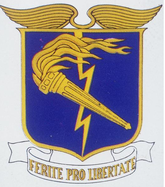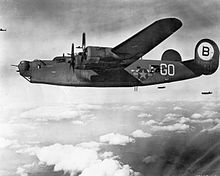93rd Operations Group
This article includes a list of general references, but it lacks sufficient corresponding inline citations. (March 2017) |
| 93d Operations Group | |
|---|---|
Distinguished Unit Citation[1] | |
| Insignia | |
| 93d Operations Group emblem[1][note 1] |  |
| 93d Bombardment Group emblem[2] |  |
The 93d Operations Group is an inactive
During World War II, the group's predecessor unit, the 93d Bombardment Group was the first
. The group became operational with a mission over Occupied France on 9 October 1942.In the postwar era, the 93d Bombardment Group was one of the original ten USAAF bombardment groups assigned to
It was reactivated as the 93d Operations Group in 1991 when the wing adopted the USAF objective organization.
History
- For related history and lineage, see 93d Air-Ground Operations Wing
World War II



The 93d Bombardment Group was activated on 1 March 1942. It initially prepared for combat with Consolidated B-24 Liberators. Engaged in antisubmarine operations over the Gulf of Mexico and the Caribbean Sea as part of the III Bomber Command, May– July 1942.
The group moved to England, August– September 1942, and was assigned to Eighth Air Force. It was assigned to the
While the 93d was at RAF Alconbury, His Majesty,
On 6 December 1942 most of the group was transferred to
The balance of the 93d BG was moved to RAF Hardwick (Station 104), in Norfolk where B-24 groups were being concentrated. From February 1943 and until the end of June the group bombed engine repair works, harbors, power plants, and other targets in France, the Low Countries, and Germany.
A detachment returned to the Mediterranean theatre during June and July 1943 to support the
After the detachment returned to England in August 1943, the group flew only two missions before the detachment was sent back to the Mediterranean to support the
The detachment rejoined the group in October 1943, and until April 1945 the 93d concentrated on bombardment of strategic targets such as marshalling yards, aircraft factories, oil refineries, chemical plants, and cities in Germany. In addition it bombed gun emplacements, choke points, and bridges near
The 93d Bombardment Group ceased combat operations in April 1945, and returned to
Strategic Air Command
The 93d Bombardment Group (Very Heavy) was activated at Merced Field, California on 21 June 1946 which was assigned to Merced for
On 1 October 1946 the airfield was put on "minimal operations on caretaker status", with control of the facility under Colorado Springs AAF. The 93d Bomb Group, however remained active. It, along with the
On 1 May 1947,
Upon its return to Castle in 1951, the group was re-equipped with B-50s. In June 1952 the group was inactivated when Strategic Air Command reorganized its wings into the dual deputate system.
Reactivation
On 1 September 1991, the 93d Bombardment Wing was redesignated as the 93d Wing under the "Objective Wing" concept adopted by the Air Force. The flying components of the wing were reassigned to the newly renamed 93d Operations Group.
As part of their new mission, the 93d Group also gained the Boeing B-52 Stratofortress squadrons from the 93d Wing. However, the operations of the reestablished group was short, On 1 June 1992 the 93d was relieved from assignment to SAC and was reassigned to the newly formed Air Combat Command (ACC). Its B-52G aircraft given the ACC tail code of "CA" and carried blue tail stripes. The 328th Bomb Squadron was inactivated 3 May 1994, and the wing and group were placed on non-operational status. The group was inactivated on 31 October 1994.
Just four months later, however, it was reactivated as the operational arm of the 93d Air Control Wing and was reactivated at
Some crews and aircraft deployed from Robins to Bosnia-Herzegovina in 1996 to support the
Upon inactivation on 1 October 2002; Georgia Air National Guard's 116th Air Control Wing assumed command responsibility for JSTARS mission.
Lineage
- Constituted as the 93d Bombardment Group (Heavy) on 28 January 1942
- Activated on 1 March 1942
- Redesignated 93d Bombardment Group, Heavy in c. 20 August 1943
- Redesignated 93d Bombardment Group, Very Heavy c. 6 July 1945
- Redesignated 93d Bombardment Group, Medium c. 28 May 1948
- Inactivated on 16 June 1952[3]
- Redesignated 93d Operations Group on 28 August 1991
- Activated on 1 September 1991
- Inactivated on 31 October 1994
- Activated on 29 January 1996
- Inactivated on 1 October 2002
Assignments
- III Bomber Command, 1 March-2 August 1942
- 1st Bombardment Wing, 6 September 1942
- 2d Bombardment Wing, 6 December 1942
- Attached to: 201st Provisional Combat Bombardment Wing, 25 March-13 December 1943
- 20th Combat Bombardment Wing, 13 September 1943 – 12 June 1945
- Second Air Force, June 1945
- Strategic Air Command, 21 March 1946
- Fifteenth Air Force, 21 June 1946
- Far East Air Forces, 15 May-25 August 1948, Far East Air Forces Bomber Command, 15 July 1950 – 30 January 1951, not operational after 10 February 1951)[4]
- 93d Wing (later 93d Bomb Wing), 1 September 1991 – 31 October 1994[4]
- 93d Air Control Wing, 29 January 1996 – 1 October 2002[4]
Components
- 12th Airborne Command and Control Squadron: 29 January 1996 – 1 October 2002
- 16th Airborne Command and Control Squadron: 29 January 1996 – 1 October 2002
- 93d Training Squadron: 29 January 1996 – 1 October 2002
- 328th Bombardment Squadron: 1 March 1942 – 15 June 1952;[3]1 September 1991 – 31 October 1994
- 329th Bombardment Squadron: 1 March 1942 – 15 June 1952[3]
- 330th Bombardment Squadron: 1 March 1942 – 15 June 1952[3]
- 409th Bombardment Squadron: 1 March 1942 – 6 July 1945; 20 August 1945 – 6 May 1946[3]
- 924th Air Refueling Squadron: 1 September 1991 – 31 October 1994
Stations
|
|
Aircraft
- Consolidated B-24D/H/J/L/M Liberator, 1942–1945, 15 May-25 August 1948,
- Boeing B-29 Superfortress, 1945–1949; 1950–1951, 15 May-25 August 1948,
- Boeing B-50 Superfortress, 1949–1950; 1950–1952, 15 May-25 August 1948,
- Boeing B-52G Stratofortress, 1991–1994
- Boeing E-8 Joint STARS, 1996–2002
References
- Notes
- ^ The group uses the wing emblem with the group designation on the scroll. Air Force Instruction 84-105, Organizational Lineage, Honors and Heraldry, 19 March 2013, para 3.3.3
- Citations
- ^ a b Maurer, Combat Units, pp. 160-162
- ^ Watkins, pp. 38-39
- ^ a b c d e f Lineage, including stations and components, through 1952 in Maurer, Combat Units, pp. 160-162
- ^ a b c Robertson, Patsy (15 August 2012). "Factsheet 93 Air Ground Operations Wing (ACC)". Air Force Historical Research Agency. Retrieved 9 March 2017.
Bibliography
![]() This article incorporates public domain material from the Air Force Historical Research Agency
This article incorporates public domain material from the Air Force Historical Research Agency
- Freeman, Roger A. (1978) Airfields of the Eighth: Then and Now. After the Battle ISBN 0-900913-09-6
- Freeman, Roger A. (1991) The Mighty Eighth The Colour Record. Cassell & Co. ISBN 0-304-35708-1
- Maurer, Maurer, ed. (1983) [1961]. Air Force Combat Units of World War II (PDF) (reprint ed.). Washington, DC: Office of Air Force History. LCCN 61060979. Retrieved 17 December 2016.
- Maurer, Maurer, ed. (1982) [1969]. Combat Squadrons of the Air Force, World War II (PDF) (reprint ed.). Washington, DC: Office of Air Force History. OCLC 72556. Retrieved 17 December 2016.
- Ravenstein, Charles A. (1984). Air Force Combat Wings, Lineage & Honors Histories 1947-1977. Washington, DC: Office of Air Force History. ISBN 0-912799-12-9. Retrieved 17 December 2016.
- Watkins, Robert (2008). Battle Colors: Insignia and Markings of the Eighth Air Force in World War II. Vol. I (VIII) Bomber Command. Atglen, PA: Shiffer Publishing Ltd. ISBN 978-0-7643-1987-7.
External links
- The 93 Bomb Group Museum, Station 104, Hardwick. A small museum in Norfolk, UK dedicated to USAAF World War II activities.



